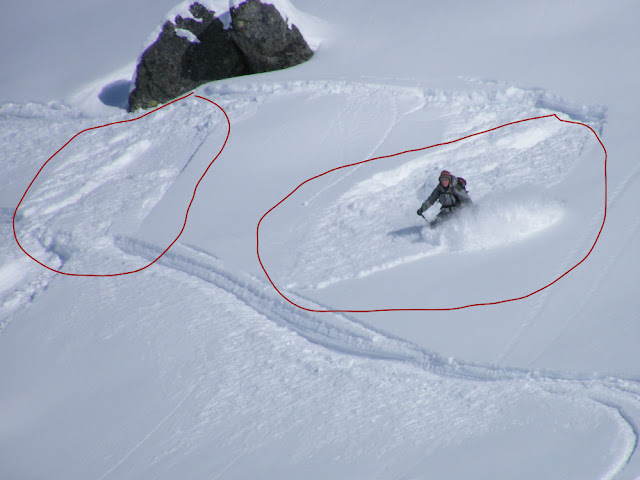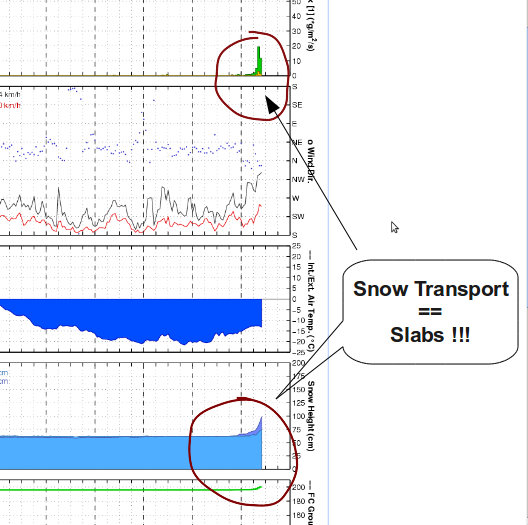This photo from yesterday gives some idea of the likelyhood of skier triggered avalanches. Just under the rock (perhaps the wind had caused some snow build up) a small soft slab has gone but doesn’t have enough momentum to travel further than the (my) ski tracks below, then some sluffing as Guy skis down the slope.

We were skiing a series of low angle pitches with benign run-outs. There didn’t seem to be a weak layer between the base and new snow (it had rained at this altitude) so the soft slabs did not have any energy to break over a larger area.
To round up the recent incidents:
Le Reposoir (Haute-Savoie). Three ski tourers heading for the col d’Ancrenaz triggered a slide at 10h40. Two of them were able
to extricate themselves from the slide and were able to locate the third victim who was completely buried. The victim was taken by helicopter to Annecy Hospital suffering from minor injuries.
At l’Alpe d’Huez two skiers triggered an avalanche around 15h00. One of the skiers suffered a number of injuries and was heliported to Grenoble hospital.
Three Dutch skiers were rescued from above cliffs at 1200m in the Romanche valley. They had skied from the top of Les Deux Alpes, following a route they had done the day before with a guide. Unfortunately they got lost on the way down. A British soldier was also rescued from les Contamines after spending an uncomfortable night in the open after getting lost.
For reference here is an extract of the 73 avalanche bulletin (risk 3 > 2000-2300 meters)
STABILITY OF SNOW PACK
SLABS CONCEALED IN THE POWDER
Cumulative snowfall since Friday morning, approaching 15 to 30 sometimes 30 cm to 40 cm in the Vanoise, Maurienne and at alitude around 2500 meters. The snow fell almost no wind (North-East to East 20 to 40 km / h). However, the pisteurs sometimes got some good results in avalanche control above 2000/2500 m. An avalanche accident occurred on Friday in Vanoise (2250 m north).
Above 2000 to 2300 m, fragile sub-layers, cold snow the last 24 hours or angular grains a little deeper, show a marked instability in case of overload. Indeed, plaques formed recently by South East wind (foehn) are still present and now hidden under the snow. In addition, the north wind may aggravate the expected local situation with the formation of new surface slabs. Many slopes are therefore a potential risk of triggering the passage of skiers (sometimes only one can suffice). Suspicion, directed by steep north-east, north and west and in south to south-west with the possibility of rupture of fragile slabs (less than 20/40 cm) or more thick and hard (40/60cm).
Below 2000 to 2300 m, the snowpack is relatively stable with both the effect of the recent warm spell (with South foehn) and deep frozen well consolidated layers. However, the north wind may again encourage the formation of some surface slabs, especially when approaching peaks. Moreover, there are still old instabilities on steep slopes facing north (north-west to north-east) and in certain areas usually cold as in Haute Maurienne. It should therefore not ignore the risk of an accidental discharge with the passage of one or more skiers.
In the Grandes Rousse the risk was 3.
FORMATION OF HARD SLABS ....< br > Wind northeast strengthens this Sunday, and on the snow surface light and easily transportable in the morning, new soft slabs will form. In the north slopes, the presence of weak layers favors the triggering of small slabs. In south-east slope to southwest, it will be particularly vigilant because the brittle slabs, powdery in appearance are likely to trigger the passage of one or more skiers.



